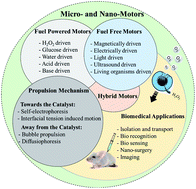Abdelmohsen et al write in the first line of this review “biological motors are one of the most remarkable products of evolution” and I couldn’t agree more. Nanoscale biomotors are common in nature and these tiny machines have inspired scientists to copy nature and attempt to develop man-made micro- and nano-motors themselves. Incredibly, machines that are as small as one 60,000th of a human hair have already been made.
Micro-machines show remarkable promise for use in a wide range of biomedical applications; including drug delivery, sensing and isolation, nanosurgery and imaging that would enable targeted or non-invasive medicine to be carried out. Although as this review points out there is still a considerable amount of work to take micro- and nano-machines for in vivo applications from concept into reality.
This paper covers topics including micro-motor design, potential fuel and fuel free machines and new developments for their use in biomedical applications and gives an interesting and balanced insight into the work of micro-machines highlighting the opportunities and challenges currently facing this field.
Micro- and nano-motors for biomedical applications
Loai K. E. A. Abdelmohsen, Fei Peng, Yingfeng Tu and Daniela A. Wilson,
J. Mater. Chem. B, 2014. C3TB21451F
H. L. Parker is a guest web writer for the Journal of Materials Chemistry blog. She currently works at the Green Chemistry Centre of Excellence, the University of York.
To keep up-to-date with all the latest research, sign-up to our RSS feed or Table of contents alert.











